Understanding money in the seventeenth-century Netherlands requires moving from the most basic elements of currency to the broader economic landscape that shaped artistic life.ions, and its purchasing power formed the backdrop against which painters worked, calculated their earnings, and navigated a crowded marketplace. At the same time, the scale of Dutch artistic production, the pressures within the art market, and the varied mechanisms for buying and selling paintings determined how easily a painter could support a household. Within this framework, it becomes possible to assess the value of Vermeer’s paintings, the financial circumstances he inherited from his family, and the deions, and its purchasing power formed the backdrop against which painters worked, calculated their earnings, and navigated a crowded marketplace. At the same time, the scale of Dutch artistic production, the pressures within the art market, and the varied mechanisms for buying and selling paintings determined how easily a painter could support a household. Within this framework, it becomes possible to assess the value of Vermeer’s paintings, the financial circumstances he inherited from his family, and the de The guilder, its subdivisions, and its purchasing power formed the backdrop against which painters worked, calculated their earnings, and navigated a crowded marketplace. At the same time, the scale of Dutch artistic production, the pressures within the art market, and the varied mechanisms for buying and selling paintings determined how easily a painter could support a household. Within this framework, it becomes possible to assess the value of Vermeer’s paintings, the financial circumstances he inherited from his family, and the decisive part played by his well-to-do mother-in-law, Maria Thins (c. 1593–1680), in his adult life.
Terminology and Early Value
In seventeenth-century sources, terms like gulden, florin, gulden (fl.), and florijn were often used interchangeably. Throughout this website, the term “guilder” is used instead of florin for consistency and clarity.Although the Dutch term was gulden, meaning “golden,” “guilder” has been the established English equivalent since at least the seventeenth century. Contemporary English texts, diplomatic correspondence, and later translations of Dutch sources routinely used guilder to refer to the same currency. The word entered English early (from Middle Dutch gulden via guilder or gylder) and remained standard for centuries. Thus, guilder is not an anachronism but a long-standing English rendering of the Dutch gulden—comparable to how florin was used in earlier English writing for the same unit. A guilder was divided into 20 stuivers (and each stuiver into 8 duiten).“Guide to Seventeenth Century Dutch Coins, Weights and Measures,” New Netherland Institute: Exploring America’s Dutch Heritage, accessed October 12, 2025.
During the Dutch Golden Age, money itself was a fluid concept. Coins in circulation—of gold, silver, or lesser metals—had no fixed nominal value guaranteed by the state. Dutch coins remained tied to their intrinsic metal content for most of the century. Each province of the Dutch Republic had its own mint, and although they followed shared guidelines, coins circulated primarily according to their metal content rather than by state-enforced value. This reflected both a mistrust of centralized authority and a preference for money that could be accepted abroad as readily as at home.
The intrinsic value of the guilder changed over time as silver and gold content were adjusted through debasements and monetary reforms. For example, a table from a Dutch source shows estimates of the “value of the guilder in grams of fine gold / silver” in various years (e.g. c. 1650, 1700).Voet, Leon. "The Golden Compasses: Notes on the Currency and Money Values in the Netherlands in the Sixteenth to the Eighteenth Centuries," appendix section. DBNL, “Appendix 6: Notes on the Currency and Money Values …” 440–442.
- In 1600: 0.927 g fine gold, 11.487 g silver
- In 1650: 0.704 g gold, 10.333 g silver
- In 1700: 0.624 g gold, 10.333 g silverVoet, Leon. "The Golden Compasses: Notes on the Currency and Money Values in the Netherlands in the Sixteenth to the Eighteenth Centuries," appendix section. DBNL, “Appendix 6: Notes on the Currency and Money Values …” 440–442)..
Thus, over the seventeenth and early eighteenth centuries, the value of one guilder declined modestly (in terms of gold content) but held more stable in silver terms.
The idea of money as a nominal value—set by government decree rather than by substance—had emerged elsewhere in Europe during the late Middle Ages, when rulers began assigning legal-tender values to coins that no longer corresponded precisely to their metal content. Such manipulation allowed monarchs to finance expenditures by debasing their currency. The Dutch Republic, governed by merchant interests and lacking a sovereign ruler, resisted this trend. It built its financial order on reliability and shared confidence. The Dutch guilder thus retained a close link to its silver weight, reinforcing trust in trade and preserving the Republic’s reputation for sound money. Institutions such as the Amsterdamsche Wisselbank (fig. 1),The Amsterdamsche Wisselbank, founded in 1609, was a municipal bank established to stabilize the chaotic monetary system of the Dutch Republic, where hundreds of types of coins circulated with fluctuating values. Operated by the city of Amsterdam, it functioned as a public clearinghouse where merchants could deposit coins of varying origin and receive credit in standardized bank money, known as bankgelùz, whose value was fixed and guaranteed by the city. The Wisselbank secured foreign merchants by settling debts through the bank and by offering account holders its own currency of stable value. This stability was achieved because of the requirement that the bank had to maintain its reserves of coins and precious metals equal to nearly 100 percent of its deposits. This innovation made payments more secure and efficient, allowing large commercial transactions to be settled by simple book transfers rather than the exchange of physical coins. The Wisselbank became a cornerstone of Amsterdam’s rise as a global financial center during the 17th century, influencing the later development of central banking across Europe. founded in 1609, upheld this principle by valuing coins strictly according to their fine metal content. As a result, the guilder became one of Europe’s most dependable currencies.
The gradual shift toward nominal or token value in the Netherlands came only in the late seventeenth and eighteenth centuries. The Wisselbank did not initiate this change; rather, it stabilized exchange by accepting worn, clipped, or foreign coins and crediting depositors with a uniform balance known as bank money (bankgeld). This parallel currency, consistently valued and transferable by bookkeeping entries, became standard for large-scale and international payments. Physical coins, meanwhile, continued to circulate by weight. Because many coins were clipped or worn, Dutch merchants and householders routinely used small balances to verify their worth.
This distinctive system was integral to the Republic’s rise as Europe’s financial center. The country’s prosperity depended on a network of exchanges—Amsterdam’s bourse, provincial mints, and the global flow of bullion from Spanish America and Asia—all requiring constant adjustment between real and nominal value. Dutch coins were treated less as abstract symbols of wealth than as commodities whose substance defined their worth. As Timothy Brook observes in his Vermeer's Hat: The Seventeenth Century and the Dawn of the Global World,Timothy Brook, Vermeer’s Hat: The Seventeenth Century and the Dawn of the Global World (London: Bloomsbury Publishing, 2009). in the seventeenth-century Netherlands “money was a commodity before it was a symbol,” its value resting not on royal decree but on a collective culture of precision, trust, and vigilance.
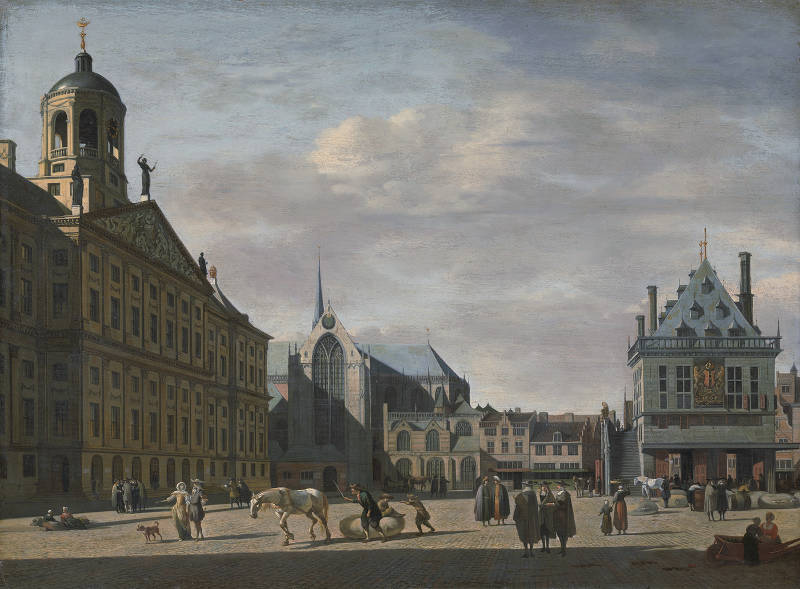
Gerrit Adriaenszoon Berckheyde
1674
Oil on panel, 43.5 x 60 cm.
Amsterdam Museum, Amsterdam
The material understanding of money also entered Dutch art, which often reflected the moral and practical concerns of a society shaped by commerce. In Vermeer’s Woman Holding a Balance, the moment depicted precedes any act of weighing (fig. 2). A few coins lie scattered near the table’s edge, beside a small stack of brass weights used for balancing, but the woman’s delicate scales remain empty. She is not yet measuring gold or silver but testing the equilibrium of the instrument itself—a state of stillness that invites reflection rather than transaction. Vermeer thus transforms an ordinary act of weighing into a meditation on judgment and restraint, aligning moral balance with material precision in a society where value—whether in coins or conduct—had to be continually verified.
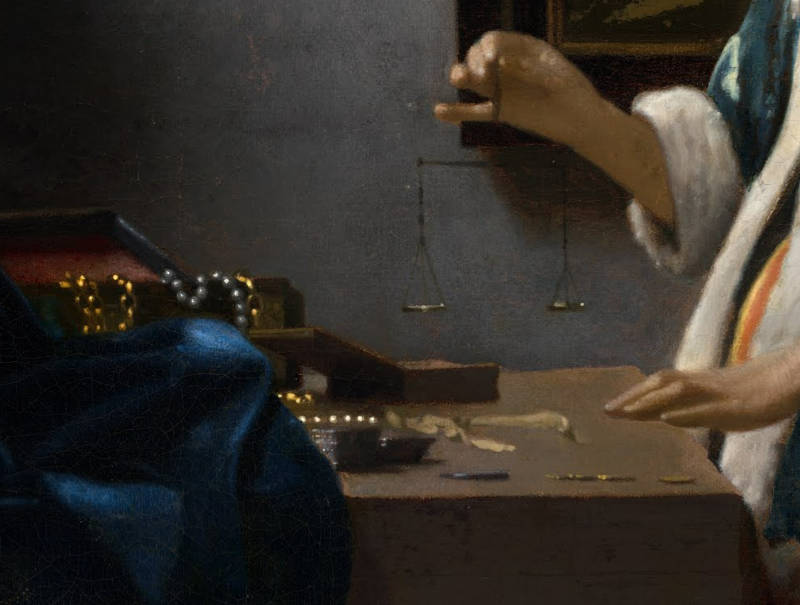
Johannes Vermeer
c. 1662–1665
Oil on canvas, 42.5 x 38 cm.
National Gallery of Art, Washington D.C.
Other than coin shaving, counterfeiting was a persistent problem throughout the seventeenth-century Netherlands. The Republic’s decentralized minting system, combined with the intrinsic value of its coinage, made falsification especially profitable. Because Dutch coins were valued by weight rather than face, counterfeiters sought to mimic the alloy and stamp of genuine guilders and stuivers, often working in border regions or under the protection of foreign nobles. Numerous executions and confiscations are recorded in Amsterdam, The Hague , and Deventer during this period, suggesting how porous the line could be between commerce and crime in a rapidly expanding money economy.
One of the most striking episodes in Vermeer’s family history involves his maternal grandfather, Balthasar Gerrits (c.1573–c.1615), who became entangled in a notorious counterfeiting scheme in The Hague in 1610. As John Michael Montias recounts in Vermeer’s Milieu: A Web of Social History,John Michael Montias, Vermeer and His Milieu: A Web of Social History (Princeton, NJ: Princeton University Press, 1989), 23–34. Balthasar, once a merchant’s broker and later described as a “clockmaker” or “engineer,” joined a circle of financiers and officials engaged in forging coins. Working with his son Reynier Balthens, and a small group that included the Resident of Brandenburg, Hendrick Sticke, and a merchant named Gerrit de Bury, Balthasar helped manufacture false three-stuiver coins and groschenA Dutch groschen was a small, low-value coin used for everyday transactions, forming part of the minor silver currency that circulated alongside the stuiver and the guilder. It usually served as a subdivision of the stuiver, though its precise value varied by province because each mint followed its own standards; in practice it amounted to only a fraction of a stuiver. In the 17th century it functioned as ordinary small change, appearing in tavern bills, craft expenses, and similar daily records, far from the guilder-based sums involved in rents, art purchases, and other substantial payments. in a rented house in The Hague.
The operation was discovered by the authorities, and the affair quickly widened into a scandal involving men of rank and influence. Sticke and De Bury were condemned by the Amsterdam burgomasters and executed by the sword on August 8, 1610, while Balthasar and his son managed to escape prosecution. Montias found no record of further punishment for the family, and by 1611 Reynier had returned to Delft. Vermeer, born decades later, could not have known his grandfather but would certainly have heard of this event, which Montias called “an inescapable part of his own background.” He notes with irony that Vermeer himself became a counterfeijterThe Dutch word counterfeijter (also written conterfeijter, konterfeyter, or contrafeyter) could mean “painter,” “portraitist,” or “copyist,” but it also carried an older sense related to imitation. Because of this, the term sometimes overlapped with ideas of illusionistic painting in the 17th-century Netherlands. —a counterfeiter of the visible world—an artist who recreated reality with deceptive precision.
Purchasing Power & Wages
Metal content alone does not capture what one guilder could buy. Better is to compare to wages, food costs, etc.
- One useful benchmark: an unskilled laborer in mid-seventeenth-century Netherlands might earn about 300 guilders per year (i.e. ~6.5 guilders per week). Willem van Osnabrugge, “Money in the 17th Century Netherlands,” vanosnabrugge.org, 2016, accessed October 12, 2025.
- Some modern estimates convert 100 guilders in the 1600s to about USD 6,000 in today’s money (a rough approximation of purchasing‐power equivalence).Willem van Osnabrugge, “Money in the 17th Century Netherlands,” vanosnabrugge.org, 2016, accessed October 12, 2025.
Using those benchmarks, one could argue that:
- In mid-17th century, 1 guilder was a nontrivial amount: enough to buy a substantial quantity of food, pay partial rent, etc.
- By the 18th century, general inflation, currency adjustments, and changes in living standards meant that the purchasing power of a guilder gradually eroded relative to “modern money,” though among collectors, art prices still surged in absolute guilder terms.
Later Developments and Effects by ~1800
- During the late eighteenth century, the Bank of Amsterdam’s “bank florin” or “bank guilder” still played an important role in Dutch monetary affairs. The Dutch bank florin/guilder was a major currency in European money markets during the seventeenth and eighteenth centuries.Stephen Quinn and William Roberds, “Death of a Reserve Currency,” International Journal of Central Banking (December 2016), accessed October 12, 2025.
- However, by the 1780s, some of the Bank’s policies made its reserves less secure, which affected the stability of the currency.Stephen Quinn and Willi., https://www.ijcb.org/journal/ijcb16q4a2.pdf.
- After the French annexation (c. 1810) and later monetary reforms, the Netherlands reintroduced a decimalized guilder (1 guilder = 100 cents) in 1817.Stephen Quinn and William Roberds, “Death of a Reserve Currency,” International Journal of Central Banking (December 2016), accessed October 12, 2025.
- Because of these reforms, early nineteenth-century guilder values are less directly comparable to the seventeenth-century ones.
Rough Comparative Scale over Time
Putting all these pieces together, here is a rough relative scale:
| Period | Approx metal basis | Equivalent purchasing power (modern rough) | Notes |
|---|---|---|---|
| Mid-17th century (c. 1650) | ~0.7 g gold / ~10.3 g silver | 1 guilder ≈ USD 60 – 100 (by wage/consumption comparison) | A wage of ~300 guilders/yr as benchmark |
| Late 17th – early 18th century | Slightly lower gold content | Some erosion in real value vs. goods | Debasement, inflation |
| Mid-18th century | Currency more benchmarked to “bank guilders” | 1 guilder still significant, but “art price inflation” major | Collectors paid hundreds of guilders for paintings |
| Circa 1800 | Reformed currency, somewhat different standard | Hard to compare directly | New decimal system after 1817 |
Everyday Prices in the Netherlands: Food, Housing, and Clothing in Vermeer’s Time
Food Staples (c. 1650–1660)
| Item | Typical Price | Notes |
|---|---|---|
| Loaf of bread (white wheat, ~1 kg) | 2–3 stuivers (≈ ¹⁄₁₀ guilder) | About ten loaves for 1 guilder; prices regulated by city councils. |
| Beer (1 pint mug) | 1–1½ stuiver | Daily beverage, cheaper than wine or milk. |
| Butter (1 lb) | 6–8 stuivers (~⅓ guilder) | Seasonal price variations; considered a luxury fat. |
| Beef or mutton (1 lb) | 4–6 stuivers | Consumed occasionally by urban households. |
| Herring (one fish) | 2 stuivers | Staple protein; barrel (~800 fish) 4–6 guilder. |
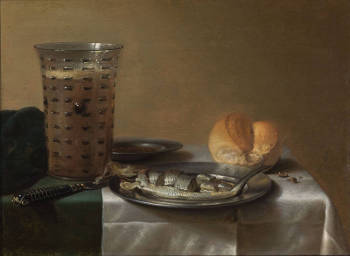
Pieter Claesz
1636
Oil on panel, 36 x 49 cm.
Museum Boijmans Van Beuningen, Rotterdam
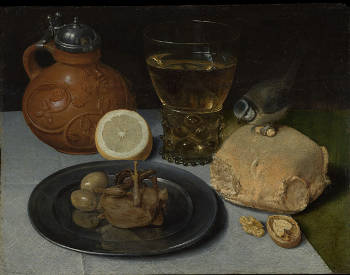
Georg Flegel
c. 1625–1630
Oil on wood, 27 x 34 cm.
The Metropolitan Museum of Art, New York
Housing and Rent
| Item | Typical Price | Notes |
|---|---|---|
| Small urban house in Delft | 800 – 1,500 guilder. | Simple two-story brick dwelling, no canal frontage. |
| Canal house in Amsterdam | 3,000 – 6,000 guilder. | Prime locations could exceed 10,000 guilder. |
| Annual rent (craftsman’s dwelling) | 60 – 120 guilder. | Roughly 20–30 % of a skilled worker’s income. |
Clothing and Household Goods
| Item | Typical Price | Notes |
|---|---|---|
| Woolen working-man’s coat | 4 – 8 guilder. | Heavy serge or broadcloth; practical garment. |
| Woman’s linen chemise | 1 – 2 guilder. | Everyday undergarment. |
| Pair of leather shoes | 2 – 3 guilder. | Durability varied by craft quality. |
| Middle-class wool or silk gown | 15 – 30 guilder. | Fabric cost usually exceeded tailoring cost. |
| Bed with mattress and bedding | 25 – 50 guilder. | Large household expense. |
Wages and Income Benchmarks
- Unskilled laborer: ≈ 300 guilder per year
- Skilled craftsman or mason: 400 – 600 guilder.
- Schoolmaster or clerk: 700 – 1,000 guilder.
- Prosperous merchant or brewer: 3,000 guilder and above
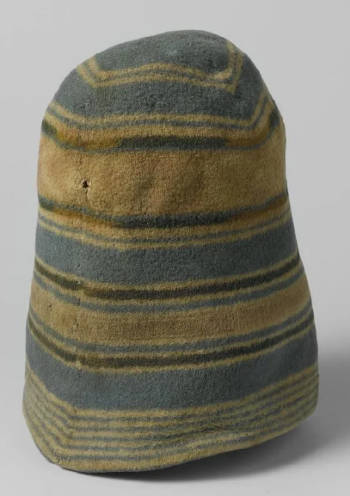
Anonymous
c. 1700–1800
Knitted wool, 35 x 30 x 29.5 cm.
Rijksmuseum, Amsterdam
Clothing prices in the Dutch Golden Age varied widely according to material, workmanship, and social class, making it difficult to fix an average value. Basic garments of coarse wool or linen were within reach of most urban households, but fine fabrics such as silk, damask, or lace could cost as much as a servant’s annual wage. Inventories from Delft and Leiden show that even middle-class families often owned only a few changes of clothing, while the wealthy invested large sums in wardrobes that displayed rank and prosperity. Because the textile industry formed the backbone of the Dutch economy—Leiden alone employed thousands of weavers—the cost of clothing reflected both local production and the Republic’s vast trading networks that imported cloth from England, France, and Asia.
Textile prices are better documented than the finished garments themselves. In the mid-seventeenth century, a good quality woolen cloth might sell for 4 to 6 guilders per ell (about 70 cm.), while finer silks could reach ten times that amount. Tailoring and trimming often doubled the total cost. Scholars such as Willem van Osnabrugge and John Michael Montias emphasize that clothing, like other goods of the Dutch household economy, embodied a balance between thrift and display—a cultural principle visible in both inventories and portraiture, where dress served as a visual index of virtue, wealth, and moderation.
Clothing in the Dutch Golden Age often underwent multiple lives within a household and across generations. For the poor and middle classes especially, new garments were expensive, and textile waste was unthinkable. As a result, children’s clothes frequently derived from worn adult outfits—recut, resized, patched, and passed down (fig. 3). While direct archival evidence in the Dutch context is sparse, costume historians have long argued that the distinction between “children’s clothes” and “adult clothes” in early modern Europe was far less sharp than today: children were often dressed as miniature versions of adults or in garments adapted as they outgrew them.“Children didn’t always wear ‘kid’s clothes’ … younger generations wore … the same clothes their parents were wearing—with few alterations for smaller, growing bodies.” — Playing Dress Up: Kid’s Clothing in the 17th Century (The Pragmatic Costumer) (The Pragmatic Costumer) Additionally, the concept of “breeching” (when boys ceased wearing dresses and began to wear breeches) suggests that before that point, children of both sexes wore garments similar to adult ones. (en.wikipedia.org) In the Netherlands, where thrift was culturally valorized and textiles formed a major economic resource, reusing worn clothing for growing children would have been a pragmatic norm.
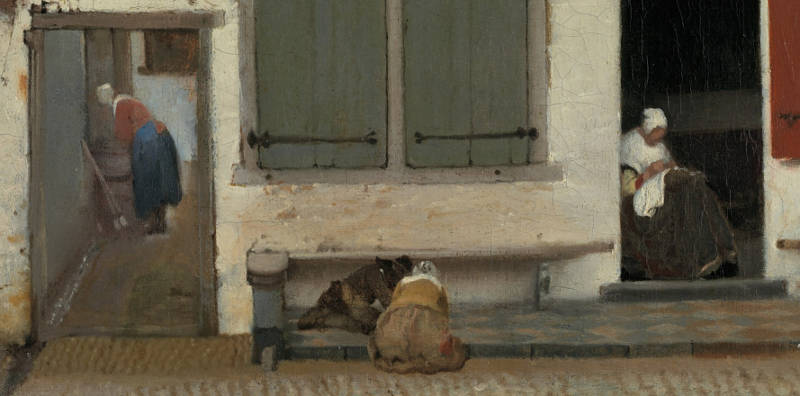
Johannes Vermeer
c. 1657–1661
Oil on canvas, 54.3 x 44 cm.
Rijksmuseum, Amsterdam
This practice gives us a sharper view of the material reality behind the polished surfaces of Golden Age portraits. What appears in a painting as a finely tailored child’s outfit may in fact carry the history of previous stitching, hems let out, and fabric reallocation. Clothing thus embodied not only social distinction but also a household’s economy of reuse. It underscores how, in a society that prized moderation and industry, garments functioned as both display and durable resource—a visual and material link between past and present wearers.
The Rise and Fall of Dutch Artistic Production
Michael NorthMichael North is a German historian. He studied Eastern European History, Medieval and Modern History and Slavic Studies. He received his doctorate in 1979 in Gießen. Since 1995 he has held the chair of General History of the Modern Era at the University of Greifswald. His main research interests in the context of the history of Europe include in particular the history of the Netherlands, the history of the Baltic Sea region, the history of money and banking, communication as well as art markets and collections. proposes two forces defined the Dutch Republic’s unique position in early modern Europe—commercialization and innovation—each reshaping the economy, society, and artistic production.Michael North, Art and Commerce in the Dutch Golden Age (New Haven & London: Yale University Press, 1997), 132–138. As feudal structures eroded, agriculture, labor, and trade came under the logic of supply and demand. Wealth, not birth, determined social standing, and although political power remained largely in the hands of an elite, economic opportunity was broadly diffused. The same market forces that transformed agriculture also revolutionized art. The traditional bond between artist and patron weakened, and paintings became freely marketable goods, produced for a wide spectrum of buyers. While the painters’ guilds maintained authority over training and sales practices, they could not restrict the sheer volume of artistic production or imports.
Innovation, the second defining feature, pervaded all sectors—from shipbuilding to horticulture—and made Dutch goods competitive at home and abroad. Painting reflected this inventive climate through new techniques such as tonal painting, which reduced costs and encouraged secular subjects that appealed to a broad, middle-class clientele. For the first time in European history, art became a mass commodity, its ownership spreading across social classes. The rise of genre scenes and landscapes mirrored both the prosperity and the Calvinist ethos of the time, which favored moral instruction over religious imagery.
By the late seventeenth century, both the Dutch economy and art market had reached a state of saturation. Demand shifted from contemporary works to older or foreign masterpieces, reducing the number of active painters and slowing innovation, especially in smaller cities. This stagnation inevitably affected the prices of paintings. During the height of the Dutch Golden Age, abundant demand from a prosperous middle class had kept prices relatively stable and allowed even modest households to own art. But as production began to outpace new buyers, paintings increasingly competed within an oversupplied market, and the shift in taste toward old masters further weakened demand for living artists. While exceptional paintings—such as Vermeer’s View of Delft or Allegory of Faith—could still command high prices because of their rarity, quality, or subject, most painters faced declining returns. The Dutch experience thus paralleled that of Renaissance Italy: both societies combined economic dynamism with artistic creativity, only to see vitality fade when competition diminished. Yet, even as production slowed and profits shrank, the Netherlands retained the cultural and material legacy of an age when commerce and creativity had briefly reinforced each other on an unprecedented scale.
Market Forces
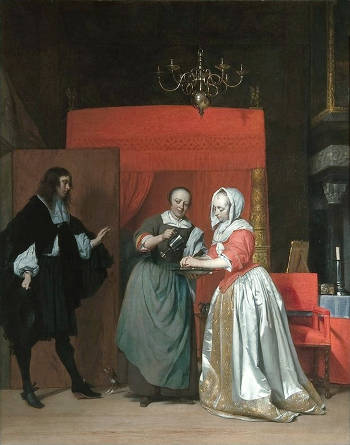
Gabriel Metsu
c. 1662–1664
Oil on canvas, 83.7 x 67.4 cm.
Private Collection
The seventeenth-century Dutch art market was anything but uniform. Beneath the broad prosperity that sustained thousands of painters, individual careers unfolded within a finely graded hierarchy shaped by reputation, subject matter, and the willingness of buyers to pay for meticulous labor. Prices recorded in inventories, dealer stock, and estate valuations show that even within the narrow field of genre painting, works could circulate at sharply different levels. These records, though often conservative, reveal how painters clustered into recognizable tiers and how shifts in demand—whether driven by taste, scarcity, or the collapse of a major dealer—could send valuations rising or flattening. Within this environment the following cases illustrate how market forces operated in practice, from rapid appreciation on the secondary market to unexpectedly modest prices for artists now regarded as central to the tradition.
Caspar Netscher (1639–1684) asked 50–140 in the 1660s, yet after the prosperous art dealer Gerrit Uylenburg (c.1625–1679)’s 1675 bankruptcy his stock lists genre Netschers at 140–500 ( "Een treffelijk stuck musicqsingers…" at 500), implying quick appreciation of prime pieces on the secondary market. Gabriel Metsu (1629–1667) could show appraisals between 25 and 160, with a standout piece estimated 270 in dealer stock; given the labor in works like Man Visiting a Woman Washing her Hands (fig. 4) and the letter pendants, one suspects first owners paid more. Gerrit ter Borch (1617–1681) presents similar tensions: a “shepherdess” in Johannes de Renialme (c.1600–1657)’s stock was set at 120 in 1657, while other attributions fall 25–80—again, numbers that feel low beside the meticulous surfaces and complex staging of works like The Suitor’s Visit or Lady at her Toilet. By contrast, Ochtervelt sits mostly 25–75, and de Hooch was surprisingly modestly priced for much of the period. Lower down, Van Brekelenkam appears in inventories at 5–20, while Ludolf de Jongh (1616–1679) is repeatedly valued 3–16 in dealer stock, despite period talk of higher asks.
Portrait practice followed its own arithmetic. In Delft a respectable likeness might run ~30 guilders, and there was a rough-and-ready 6-guilder day-portrait tier; at the top, Rembrandt (1606–1669) charged ~50 for a head, ~100 per person in group works, and up to 500 for a life-size single figure. Frans Hals (c.1582–1666) priced a militia piece per head at 60 (sixteen sitters totaling 960). Such rates help explain why portraitists could ride steadier incomes than genre specialists who depended on discretionary purchases.
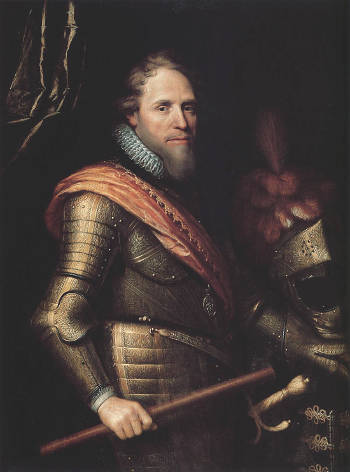
Michiel Jansz. van Miereveld
1607
Oil on panel, 110 x 98 cm.
Gemeente Musea, Delft
Michiel Jansz. van Miereveld (1567–1641) exemplifies how a successful painter in the Dutch Republic could transform artistic skill into sustained prosperity and social prestige (fig. 5). Based in Delft, he became one of the leading portraitists of his time, maintaining strong ties with patrons in The Hague and securing the coveted position of court painter to the House of Orange. His reputation was such that his name alone guaranteed commissions from magistrates, diplomats, and members of the nobility.
Miereveld’s success was built on a rigorous, conservative style and carefully organized and highly productive workshop system. The demand for his portraits was so great that his studio functioned much like a commercial enterprise, with a clear division of labor among assistants, family members, and journeymen. His sons and grandsons helped manage the flow of commissions, and specialized workers executed backgrounds, clothing, and accessories. The master often reserved the final touches or the sitter’s face for himself. Copies and variants were produced in abundance, many of which Miereveld signed as his own, a common and accepted practice among prosperous painters. Portraits for court patrons were sometimes completed by assistants in advance and kept in stock for future requests, then finished or merely authenticated by Miereveld’s signature. His earnings reflected both his fame and his efficiency. While a modest portrait by a lesser Delft painter might sell for 30 guilders, Miereveld’s works commanded many times that amount. His careful distinction between personally executed paintings and those completed largely by his studio allowed him to manage production and price strategically. At his death in 1641, his estate was valued between 25,000 and 30,000 guilders—an immense fortune that placed him among Delft’s elite citizens. Miereveld’s disciplined workshop, reliable craftsmanship, and court connections demonstrate the ideal model of a successful Dutch artist: one who combined technical mastery with business acumen and maintained artistic credibility while operating within a market-driven system.
Subject and fashion shifted the averages across the century. In 1600–1625, history paintings lead (about 47.6 on average), then religious (33.0), landscape (30.3), genre (27.8), still life (27.4), with portrait last (about 6.0). By 1676–1700, genre has surged to ~88.2, ahead of history (65.3) and religious (52.1), with landscape (44.0) and still life (41.3); portrait rises to ~37.1, while architectural subjects fade to ~22.5. These arcs chart not only taste but also production economies—tonal landscape techniques cut time, multiplying supply and tugging means down—while small, finely worked genre scenes concentrated labor and scarcity, pushing means up.
Named landscape prices reinforce the spread. Jan van Goyen (1596–1656) (fig. 7) appears cheap in many resales (down to the 30–50 range) but could command 650 for a 1651 official commission; Jacob van Ruisdael (c.1628–1682) registers 60, 100, 80 in separate years; Allart van Everdingen (1621–1675) shows 150 and 100; Philips Wouwerman (1619–1668) climbs to 355 and 255 as taste turns to equestrian and camp scenes (fig. 6). Commissions, format, and subject all mattered.
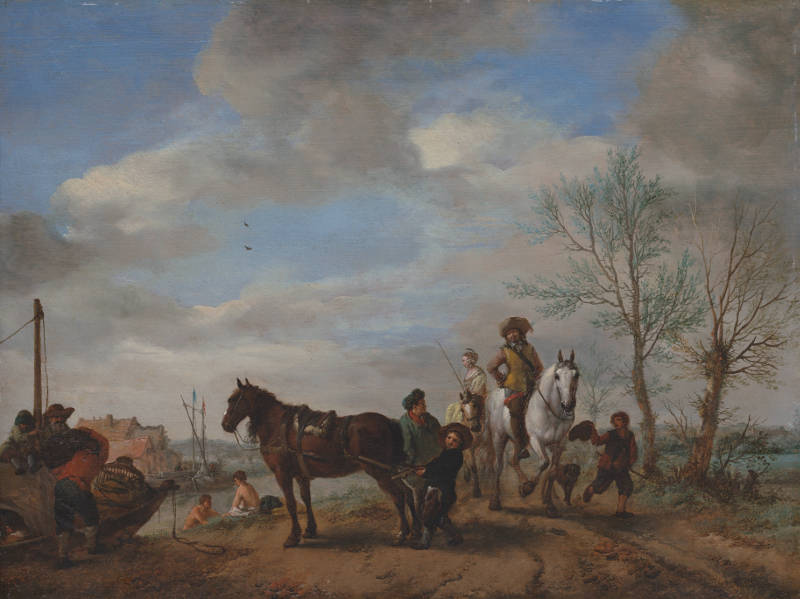
Philips Wouwerman
c. 1653–54
Oil on wood, 30.8 x 41.3 cm.
The Metropolitan Museum of Art, New York
Painters' wealth was far from stable, their economic situation could be drastically overturned for a variety of reasons. Despite Van Goyen's vast artistic output,Best current museum-source consensus puts Jan van Goyen’s output at about 1,200 paintings (and roughly 1,500 drawings). The Rijksmuseum biography states “more than 1,200 paintings and about 1,500 drawings,” which aligns with other major references. in 1652 and 1654, he was forced to sell his collection of paintings and graphic art, and he subsequently moved to a smaller house. He died in 1656 in The Hague, 18,000 guilders in debt, forcing his widow to sell their remaining furniture and paintings. Despite his market innovations, he always sought more income, not only through related work as an art dealer and auctioneer but also by speculating in tulips (he was the last known victim of the tulip mania of the 1630s) and real estate. Although the latter was usually a safe avenue of investing money, in van Goyen's experience it led to enormous debts. ) Van Goyen's troubles also may have affected the early business prospects of his student and son-in-law Jan Steen, who left The Hague in 1654.
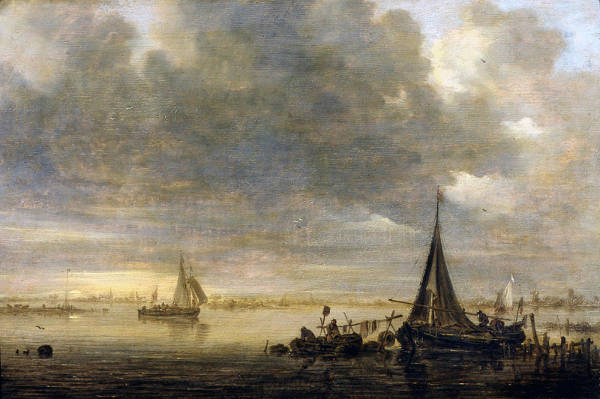
Jan van Goyen
1643
Oil on panel, 41 x 61 cm.
Musée des Beaux-Arts, Strasbourg
Rembrandt rose to great wealth and prestige in Amsterdam during the 1630s and 1640s, earning substantial commissions and investing heavily in art, prints, and antiques. However, his financial situation deteriorated sharply after the early 1650s. Several factors contributed: he overextended himself with expensive property purchases—most notably his grand house on the Breestraat—and maintained a costly lifestyle despite declining commissions. The art market itself also weakened after the economic downturn of 1653. Mounting debts led him to declare insolvency in 1656, after which his possessions and art collection were auctioned. He continued to work but lived modestly under the legal protection of his son Titus’s and Hendrickje Stoffels’s business arrangements until his death in 1669.
Underneath the prices lay the economics of labor. Contracts and bookkeeping suggest an able professional could net ~1,150–1,400 guilders per year—roughly three times a master carpenter—if work flowed. A day-rate entry catches Caesar van Everdingen (c.1616–1678) at 3 guilders/day painting organ doors in 1643–1644, while a master carpenter earned ~1 guilder/day. In that wage world, a 100-guilder picture is serious discretionary spending; 600 marks a luxury; 4,000 belongs to the realm of gifts between states. Dou could approach that upper income tier by painting only about five works at prevailing valuations; Van Brekelenkam, by contrast, needed 100–150 quickly executed pictures a year, a burden that, according to an eighteenth-century biographer, fed hurried workmanship. The broader free market for cheap pictures contracted after 1660 and effectively collapsed after 1672, further stressing painters who depended on volume. As households liquidated assets during the downturn, and the owners of previously purchased pictures died, many earlier works gradually re-entered circulation, further saturating the market and reducing demand for new production.
- Walsh, John. Jan Steen: The Drawing Lesson. Getty Museum Studies on Art. Malibu, CA: The J. Paul Getty Museum, 1996.
The decision of young boys to apprentice with a master painter and pursue an artistic career during the Dutch Golden Age arose from a compelling mix of financial ambition, social aspiration, and personal inclination. Samuel van Hoogstraten (1627–1678), a painter and art theorist, summed up these motives succinctly: “It’s love, profit, and honor that cause his heart to burn.”
Honor and social status were among the strongest incentives. Painting offered a chance for advancement within the broad middle ranks of Dutch society. A talented youth could rise considerably if he attracted a wealthy and influential clientele. Successful painters enjoyed prestige and often lived at a level comparable to that of their patrons. Van Miereveld, for example, accumulated great wealth through his portrait practice in Delft. Many artists also sought to elevate their profession by associating it with learning rather than manual labor. Their studios displayed books, globes, or plaster casts, visual proofs that painting was an intellectual pursuit. In this sense, art promised not only financial stability but also fame and honor, much as it had for the legendary Greek painter Apelles.
Profit and economic opportunity also played an undeniable role. Although competition was fierce, a successful painter could earn a comfortable income, sometimes far exceeding that of skilled craftsmen. Average annual earnings were estimated between 1,150 and 1,400 guilders—about three times what a master carpenter might make. Prestigious commissions from civic authorities or private patrons could bring exceptional rewards, while paintings themselves often functioned as valuable assets, used to settle debts or pay for goods and services.
Love, or natural inclination, was the third element in Hoogstraten’s triad. True artistic vocation was thought to stem from an innate spirit (ingenio) and a deep desire (inclinatio) to master the craft. Parents and masters alike looked for signs of this creative spark, which needed to be refined through discipline and training. For many, the act of painting itself brought fulfillment—the pursuit of la vraie vérité, the lifelike realism that stirred emotion in both painter and viewer. The saying “Love gives birth to art” (Liefde baart konst) expressed the belief that passion was the wellspring of artistic excellence.
Apprenticeship, however, required substantial investment. Painting remained a craft learned entirely in the master’s atelier, where students spent at least six years progressing from menial tasks like grinding pigments and preparing canvases to drawing and eventually executing parts of their master’s works. Training was costly: parents might pay between 50 and 100 guilders a year, often including room and board. Renowned masters such as Rembrandt and Dou charged up to 100 guilders annually for instruction alone, a sum that ensured only families of reasonable means could support such an undertaking.
For those who succeeded, however, the rewards could be immense: painting offered not only a livelihood but also social esteem and the satisfaction of a calling that united love, profit, and honor.
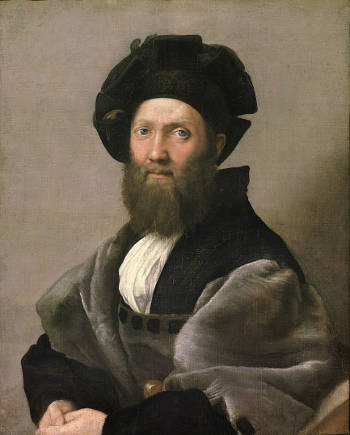
Raphael
Probably winter 1514–1515
Oil on canvas, 82 x 67 cm.
Louvre Museum, Paris
In the variegated Dutch art market, dealers, auctions, and connoisseurs mediated the very top. Fame became a pricing engine in an open market awash with types and qualities, as Samuel van Hoogstraten (1627–1678) and Franciscus Junius (1591–1677) insisted: without well-placed supporters, even virtue at the easel could languish. Collections reveal the effect: single-artist concentrations (Dou, Van Mieris, Vermeer) in elite homes, and, at the highest tier, a premium for Italian old masters that living Dutch painters rarely matched. When Lucas van Uffelen (c.1586–1637)’s collection was sold in Amsterdam in 1639, Raphael (1483–1520)’s Baldassare Castiglione (fig. 8) realized 3,500 guilders—a reminder of how strongly name and rarity could move the needle.
Taken together, these records and shopfloor insights explain why a seventeenth-century painting could cost anywhere from 1–10 guilders to 1,000 and beyond, and why a select few soared higher still. Where production was rapid and techniques economized, prices sagged toward the mean; where brushwork was very fine, time sunk deep, and ultramarine announced rarity, prices climbed. As taste swung toward elegant domestic scenes late in the century, the averages rose with it, but the surest predictor of price, across makers and decades, remained the same: how much trained time and discriminating attention a buyer could see and trust on the painted surface.
Forms of payment among artists and patrons that circulated among artists and their patrons reveal how paintings functioned as substitutes for money within the Dutch Republic’s highly monetized yet credit-dependent economy. Works of art routinely settled tavern bills, interest payments, and even rent. Jan Steen paid six percent interest on a 450-guilder loan with three portraits, while Simon de Vlieger (1601–1653) met installments on a 900-guilder house purchase through a series of paintings delivered over time. De Hooch likewise compensated his landlord partly with his own pictures—a practice that underscores how art could move fluidly between aesthetic object and negotiable asset.John Michael Montias, Vermeer’s Milieu: A Web of Social History (Princeton: Princeton University Press, 1989), 136–137. While in Delft, de Hooch worked for the wealthy linen merchant Justus de la Grange (also known as Justinius de la Oranje) during 1653–1654, probably exchanging paintings for room, board, or a modest income under a contract that described him as a dienaar (“servant”). An inventory of De la Grange’s collection dated August 28, 1655, listed eleven paintings by de Hooch and four by Jan Lievens (1607–1674). After De la Grange’s financial collapse and departure for America around 1656, de Hooch established himself independently, joining the Guild of Saint Luke in Delft as a master on September 20, 1655.
Such transactions blurred the line between cash and canvas, showing that paintings were not only commodities to be admired or traded but instruments of credit and trust embedded in the fabric of daily life.
After Vermeer’s death in December 1675, his widow, Catharina Bolnes (1631–after 1687), found herself in desperate financial straits. Among the debts she listed was a sum of 617 guilders owed to Van Buyten, accumulated over years of unpaid deliveries. Van Buyten, who had shown the family extraordinary forbearance, had accepted one of Vermeer’s paintings as partial repayment. From this document, Montias calculated that the amount represented roughly six years’ worth of bread for the large household—an extraordinary figure that provides one of the most tangible measures of the family’s economic hardship.John Michael Montias, Vermeer and His Milieu: A Web of Social History (Princeton, NJ: Princeton University Press, 1989), 210–211.
The episode underscores the reality that even a painter of Vermeer’s refinement operated at the edge of solvency. Bread was not a luxury but a daily necessity, and to be indebted to a baker was to expose one’s most basic vulnerability. A single guilder in Vermeer’s day could buy a family’s daily provisions or several loaves of bread with butter and cheese. Owning a modest home required savings in the thousands of guilders—roughly ten times a craftsman’s annual wage. The exchange of a painting for food also reveals the ambiguous position of art within the domestic economy of the Dutch Republic: a work of beauty, destined for collectors, could nonetheless become a form of sustenance when converted into credit.
The geography of the market remained largely local—painters usually sold to clients in their own cities—with Amsterdam the partial exception, where wider assortments of non-local names appear in inventories. Yet even there, elite strings of patrons like those around Dou and Van Mieris are more visible in Leiden than in the metropolis, possibly because Amsterdam’s abundance encouraged buyers to keep options open instead of attaching themselves to a single master. Vermeer’s steady support from Maria de Knuijt (c. 1623–1681) and her husband Pieter van Ruijven (1624–1674) illustrates how a single committed collector could stabilize a high-labor practice in a local frame. The main difficulty for many mid-and lower-tier painters was that they could not rely on commissions from the local elite alone. To earn a reasonable income, they had to appeal to a broader, less wealthy clientele, which meant producing more affordable works for the open market. After 1660, however, this market contracted sharply and virtually disappeared after 1672. This contraction and near collapse of the Dutch art market after 1672 was largely the result of a combination of political, economic, and social crises that struck the Republic that year—known in Dutch history as the Rampjaar, or “Disaster Year.” In 1672, the Netherlands was simultaneously invaded by France, England, and the bishops of Münster and Cologne. The war disrupted trade, devastated parts of the countryside, and shattered the confidence of the middle class that had sustained the enormous demand for paintings during the preceding decades.
The crisis led to widespread financial losses, a decline in disposable income, and a general atmosphere of uncertainty and austerity that affected even Maria Thins, the mother-in-law of Vermeer.The crisis of 1672, when the Dutch Republic was attacked by France, England, and other powers, caused a sharp economic downturn and a collapse of the art market, deeply affecting Maria Thins, Vermeer's supportive mother-in-law. Although she was a minor rentier who normally lived on income from her estates and farms, those revenues failed, forcing her to economize. Even in the midst of the turmoil she was handling financial obligations, as shown by a document dated September 13, 1672, in which she instructed a Delft notary to arrange the settlement of a 200-guilder debt with a fellow townsman in Antwerp. This situation is striking because she possessed substantial inherited wealth, which had always given her a degree of security that Vermeer’s own family never enjoyed. Art, once an everyday commodity for many prosperous burghers, quickly became a luxury few could afford. The number of active painters fell sharply, and those who continued often turned to other forms of work or sought patrons abroad. Although the economy eventually stabilized, the dynamic art market of the mid-seventeenth century never fully recovered. Vermeer was directly involved in this collapse. According to the testimony of his widow, the Rampjaar and the ensuing war with France brought about the financial ruin that hastened Vermeer’s death in 1675. In her petition to the States of Holland and West Friesland, Vermeer's wife Catharina explained that during the long and ruinous conflict her husband had been unable to sell any of his paintings and had even been left holding the works of other artists that he could no longer place on the market. With eleven children to support and no steady income, his affairs fell into decay. She recounted that the strain of this collapse so preyed upon him that, “as if he had fallen into a frenzy,” he went from being healthy to dead in a day or two. Her words portray not only the human toll of the war’s economic devastation but also the fragility of an artist’s livelihood in a society whose art market—once Europe’s most prosperous—had suddenly collapsed.
Nonetheless, in seventeenth-century Delft, a Vermeer painting priced between 100 and 200 guilders represented a substantial investment—roughly several months of a skilled craftsman’s wages, the cost of a fine harpsichord, or about a year’s rent for a comfortable home—illustrating how such works occupied the intersection of luxury and livelihood within the Republic’s prosperous yet fragile economy.
Buying and Selling Paintings in Seventeenth-century Netherlands
The information that follows was drawn from two indispensable resources:
- Waiboer, Adriaan E., ed. Vermeer and the Masters of Genre Painting: Inspiration and Rivalry. New Haven: Yale University Press, 2017.
- North, Michael. Art and Commerce in the Dutch Golden Age. New Haven: Yale University Press, 1997.
Making a Living
During the seventeenth century, the Netherlands produced an extraordinary number of painters relative to its population. Archival data from the Guilds of St. Luke show that around 650–750 painters were active across the Dutch Republic circa 1650—about one painter for every 2,000 to 3,000 inhabitants. In major cities, artistic density was even higher: Delft had 36 painters for 24,000 inhabitants, Haarlem 68 for 38,000, and The Hague—home to the court of the House of Orange—had 37 for 18,000. This remarkable concentration reflected the urban character of Dutch society and the vast demand for paintings among the middle class, a demand unparalleled elsewhere in Europe.
Painters generally came from solidly middle-class backgrounds. Few were born into poverty; their fathers were often artisans, merchants, or goldsmiths who could afford the cost of training. Montias characterizes Vermeer’s family as belonging to Delft’s broad artisan middle class, respectable but far from wealthy.John Michael Montias, Vermeer and His Milieu: A Web of Social History (Princeton, NJ: Princeton University Press, 1989), 4–11. His grandfather, Jan Reyersz. , was a tailor who lived near the Small Cattle Market, while his father, Reynier Jansz. (who alternately used the surnames Vos and Vermeer), rose modestly through work as a caffa weaver, innkeeper, and small-scale art dealer. Reynier’s marriage to Digna Baltens, who came from a similar craft background, provided stability but not affluence. Although the family never entered Delft’s patrician circles, Vermeer grew up in an environment where artisanal labor, trade, and the visual arts intersected. His father’s connections with local painters and the Guild of St. Luke likely gave him early exposure to artistic practice and to the market for paintings, laying the social and practical groundwork for his later career.
Apprenticeship usually lasted six years and required an annual payment of 20 to 100 guilders, depending on the master's reputation and whether the student boarded in his household. Famous masters like Rembrandt (1606–1669), Gerrit Dou (1613–1675), or Gerrit van Honthorst (1592–1656) could charge the upper range of these fees, a substantial sum at a time when elementary schooling cost only two to six guilders per year. Many apprentices worked for their masters without pay, as their output legally belonged to the master, who profited from their labor. Only after years of training could a painter sign and sell his own work.
In terms of income and social standing, successful painters earned well above average artisans. While a master carpenter might make one guilder a day, professional painters could earn three guilders daily, or between 1,150 and 1,400 guilders per year—roughly triple a craftsman’s income. A few, such as Abraham van den Hecken (c. 1615–after 1655) or leading portraitists, could exceed 2,000 guilders annually. Despite these advantages, painters’ fortunes were volatile; market saturation and changing tastes could swiftly ruin them, as the examples of Rembrandt , Frans Hals (c. 1582–1666), and Vermeer show.
Regarding painting categories, inventories from Amsterdam and Delft reveal clear trends. Early in the century, nearly half of all paintings were histories, but by 1700 landscapes dominated private collections, followed by genre scenes. Portraits ranked third, while still lifes held a smaller share, evolving toward more decorative floral compositions. Religious and mythological works declined sharply as domestic and secular subjects grew in popularity, reflecting the middle-class taste for familiar imagery over grand narrative art.
Pricing Paintings
Seventeenth-century Dutch painting as a profession inhabited a market that stretched from pennies-on-the-guilder wall fillers to commissions priced like luxury goods, and both the social mechanics and the technical facture of pictures shaped what buyers paid. Inventories and auction books from the 1640s already show a bifurcated world: ordinary households could acquire pictures for a handful of guilders—on average 6.8 per painting in Amsterdam estates—with “small pictures” around 3.21 and “big pictures” near 43.8; a Hague sale in 1647 puts originals at 9.3 on average and copies at 4.13, a neat index of value that attached to authorship and scale. “Unlike the high-end painters, Quiringh van Brekelenkam (c.1622–c.1669) (fig. 9) could not earn a living from only a few clients – not at his prices. Judging from existing valuations, Dou only needed to produce five paintings in order to earn an annual income of, say, 1,500 guilders; Van Brekelenkam, by contrast, had to paint about 100 to 150 works. The latter, therefore, was forced to concentrate on the free market, in his case, it seems, at the expense of quality. Adriaan Waiboer and Eddy Schavemaker, Vermeer and the Masters of Genre Painting: Inspiration and Rivalry (London and New Haven: Yale University Press, 2017), 94–95.
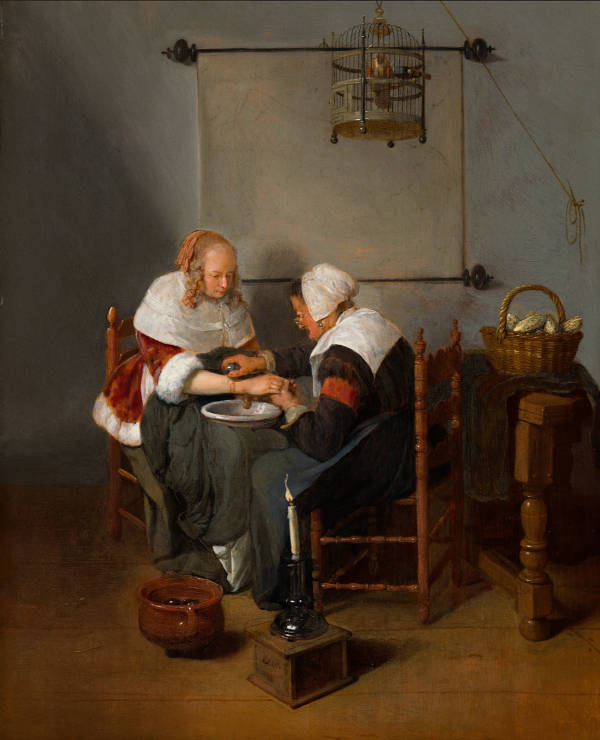
Quiringh van Brekelenkam
c. 1660
Oil on panel, 47.9 x 36.7 cm.
Mauritshuis, The Hague
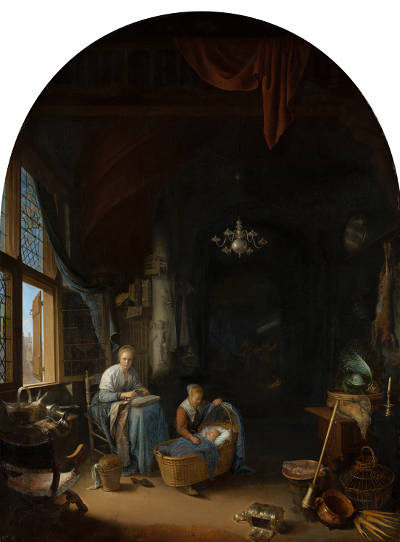
Gerrit Dou
1658
Oil on panel, 73.7 x 55.5 cm.
Mauritshuis, The Hague
At the summit stood the fijnschilderen. Dou, whose procedural slowness and microscopic finish became famous throughout Europe, generally asked in the range of 600–1,000 guilders; his Young Mother (fig. 10) was connected with the 1660 Dutch GiftIn order to appease the English king Charles II, who had just come to power, the States General of the Netherlands and the States of Holland and West Friesland offered him a large number of gifts, including about 25 paintings. The Young Mother was part of this Dutch Gift. The subject of the painting could be seen as a reference to Mary Henrietta Stuart, sister of the king and widow of stadtholder William II of Orange. She had to watch over the interests of her son under difficult political circumstances. Charles II was extremely pleased with Dou's work and tried to bring the painter to England. Dou, however, did not accede his invitation. at an extraordinary 4,000 guilders—a number that only makes sense if one remembers how much time, reputation, and connoisseur attention were compacted into these panels. Most surviving estate valuations for Dou (and for Frans van Mieris (1635–1681) land lower—100–400 guilders—but even that sits well above the going rates for most genre painters. Dou’s standing rested not only on labor and finish; patronage amplified the effect. Pieter Spiering (c.1592–1652) reportedly paid Dou a 500-Carolus-guilder annual retainer for first refusal, a rare arrangement that itself advertised value; Johan de Bye (1621–1676) owned twenty-seven Dous—collecting on a scale that created its own feedback loop of fame.
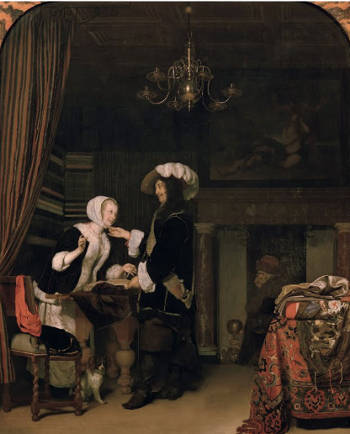
Frans van Mieris the Elder
1660
Oil on panel, 55 x 43 cm.
Kunsthistorisches Museum, Vienna
Van Mieris met that market head-on. In 1660, he delivered The Cloth Shop (fig. 11) for 1,000 guilders; a 1667 commission billed by the hour for a fainting young lady climbed to 1,500; two of his pictures were later appraised at 750 and 660. Such figures map a collector’s taste that prized painstaking texture, compact formats, and costly materials—above all the glowing blues of ultramarine. Technical study confirms that the highest price brackets cluster around two traits: a very fine scale of brushwork and verified use of ultramarine, while mid-tier painters mix strategies—smalt toning for walls, sparing ultramarine in accents—to simulate a similar look at lower cost. Pieter de Hooch (1629–1684), for instance, will wash a back wall with smalt-toned white but reserve ultramarine for tiles and costume; Jan Steen (1626–1679) and others adopt hybrid palettes. Even Jacob Ochtervelt (1634–1682), who worked quickly, used ultramarine routinely; in other words, pigment choice mattered, but the decisive variable for price remained time on the brush.
The Financial Worth of Vermeer's Paintings
Vermeer operated toward the top end of the art market with, however, fewer surviving price points. At the 1696 Dissius sale, twenty-one Vermeers ranged from 17 for a tronie to 155 for Woman Holding a Balance, 175 for The Milkmaid, and 200 for View of Delft; by 1699 the large-scale Allegory of the Faith brought 400. From these points scholars infer lifetime prices commonly in the 100–200-guilder band—enough to place him with the better-paid genre specialists even if below Dou’s stratosphere.
In any case, it is difficult to gauge the financial appreciation of Vermeer’s art following his death, since the surviving auction data reveal wide discrepancies between sales, shaped by shifting taste, subject matter, and context. The Allegory of Faith—today generally considered one of most derivative compositions—, sold for about 400 guilders in the 1699 Herman van Swoll auction, brought twice the price of View of Delft— instead considered one of his finest—which had fetched 200 guilders just three years earlier in the Dissius sale, where it was nonetheless the highest-valued Vermeer among twenty-one works, averaging only 72 guilders each. Many factors could have influenced these differences, including the smaller and more specialized nature of each sale, the buyer’s taste, and the changing fashion for highly finished, ambitious compositions. Scholars explain the unusually high price of the Allegory of Faith by its ambitious allegorical subject and composition, fine finish, and its perceived intellectual and artistic sophistication, which evidently resonated with late seventeenth-century collector despite, or perhaps precisely because of, its overtly Catholic theme.
When the French diplomat, traveling diarist, and art enthusiast Balthasar de Monconys (1611–1665) visited Vermeer in Delft on 11 August 1663, he recorded in his travelogue an episode that vividly illustrates how difficult it is to evaluate the economic value of paintings in the seventeenth-century Netherlands. Finding no finished works in Vermeer’s studio, De Monconys was directed to the home of the prosperous master baker, Hendrick van Buyten (c. 1620–1701), who owned at least one of the artist’s paintings. The work, described only as depicting a single figure, was said to have cost six hundred livres, a sum generally taken to correspond to six hundred guilders—a remarkably high price by contemporary standards. De Monconys, however, was incredulous; he remarked that he would have thought the picture “too dear at six pistoles,” or about sixty guilders, thus valuing it at scarcely a tenth of the price the baker claimed to have paid.
This striking disparity reveals the instability of value judgments in the seventeenth-century art market. To De Monconys, who was well educated but not deeply versed in painting, six hundred guilders for a single-figure composition seemed extravagant. Yet such prices were not unusual for leading masters: Dou asked the same amount for comparable works, and Van Mieris charged even more—up to 1,200 guilders for a figure piece. Vermeer’s paintings, though few in number, belonged to the same high echelon of craftsmanship and rarity. The fact that De Monconys found no paintings in Vermeer’s studio supports the view that Vermeer worked slowly and on commission rather than producing for the open market, aligning his practice with that of Leiden’s fijnschilderen, whose meticulous technique demanded immense labor and justified high prices.
Whether Van Buyten exaggerated the sum to impress his visitor or quoted the true amount, the incident underscores the complexity of translating seventeenth-century prices into meaningful economic terms. Contemporary observers like De Monconys lacked a consistent sense of what artistic excellence was “worth,” and the fluid exchange values of guilders, livres, and pistoles further complicate modern interpretation. The episode thus encapsulates the broader difficulty of comparing Vermeer’s prices with those of his contemporaries: while his works were rare and highly prized by connoisseurs, their market value could appear baffling—even excessive—to those outside the refined circles that understood their quality.
The Financial Conditions of Vermeer's Family of Origin
Johannes Vermeer entered the world in 1632 as the son of a family that worked hard to maintain itself but never reached the higher ranks of Delft society. His parents, Digna Baltens and Reynier Jansz, lived on the Voldersgracht and belonged to the modest middle layer of the urban population. They were neither impoverished nor comfortably situated. An inventory from 1623 shows they possessed a small group of paintings—still lifes, history scenes, portraits, and genre subjects—which confirms that the household, while not wealthy, moved within the orbit of the local art market. Reynier’s path through various occupations reflects this position. He began as a weaver of caffa, a woolen textile with a soft surface, before redirecting his energies into the lively business of art dealing. By 1631 he joined the Guild of Saint Luke as a master art dealer, paying the usual six-guilder entrance fee and pursuing his trade from within the inns he and his wife managed.
The family’s fortunes rose slightly but brought equal burdens. They operated the inn known as De Vliegende Vos on the Voldersgracht and, in 1641, purchased a larger house with its own inn, Mechelen, on the north side of the Markt. It was an ambitious step that required a purchase price of 2,700 guilders, covered almost entirely by a mortgage of 2,500 guilders. Such heavy borrowing made the appearance of progress somewhat deceptive. When Reynier died in 1652, the accumulated obligations did not disappear, and Vermeer, who was then in his early twenties, remained tied to the financial duties of the household. In 1655 he and his wife, Catharina Bolnes, guaranteed a debt of 250 guilders that Reynier had left unsettled. Vermeer was forced to take a fresh loan from Pieter Claesz van Ruijven to pay what his father owed, which underscores the limited resources available to him at the time.
His formal entry into the Guild of Saint Luke the previous year further illustrates the family’s circumstances. Although the sons of Delft masters usually paid only three guilders to register as painters—provided they had completed at least two years of training within the city—Vermeer paid the full six guilders. This suggests that most of his apprenticeship had taken place outside Delft and that he could not claim the reduced rate. While the fee itself was not extravagant, the fact that he did not qualify for the lower sum hints at the constraints he faced as he attempted to establish himself professionally.
Set beside the considerable wealth of his future mother-in-law, Maria Thins, these details reveal how far Vermeer had to climb to attain a level of security. That support became indispensable as the economic conditions of the 1670s tightened. Vermeer did not accumulate assets during his lifetime, and at his death in 1675 the family was left in severe distress.
In this context, his upbringing offered him familiarity with the art trade and the day-to-day commerce of an inn, but it did not furnish the financial foundation that would have eased the continuing strain of a growing household. His family of origin gave him a foothold in the world he would later depict so precisely, yet financially it remained a fragile footing, increasingly at odds with the distinguished domestic environment he inhabited through his marriage and his dependence on Maria Thins.
The Influence of Vermeer's Mother-in-Law, Maria Thins, on his Art and Life
Maria Thins occupied an unusual and decisive place in the life of her son-in-law. Although she has often remained in the margins of Vermeer scholarship, her economic position and social standing formed the financial and domestic framework in which almost the whole of Vermeer’s career unfolded. She belonged to one of the most distinguished Catholic families of Gouda, a lineage that had produced mayors and magistrates, and by the 1670s she stood among the small fraction of Delft’s population that possessed a taxable capital of at least one thousand guilders. In the register for the Groot Familiegeld—a tax reserved for the wealthy—she was assessed at roughly twenty-six thousand guilders, placing her among the five percent most affluent inhabitants of the city. Under normal conditions, this capital would have generated a yearly income of about thirteen hundred guilders, enough to allow her to maintain her household as a modest rentier relying on interest, leases, and obligations. The crisis of 1672 weakened those revenues, but she still remained far above the economic level of her daughter and Vermeer, who owned too little to be entered into the same tax lists.
Vermeer’s marriage to Catharina Bolnes in 1653 thus represented a marked shift in social position for a young painter born into a middling Delft household. By joining a family of such standing, he gained not only respectability in the Catholic community—something reinforced by his conversion—but also access to a stable domestic setting supported by his mother-in-law’s resources. The couple spent nearly their entire marriage under Maria Thins’ roof in the Catholic quarter around the Oude Langendijk, first in a rented dwelling and later in the larger house known as Groot Serpent, which she secured before 1660. Its size, location, and rent suited her means, and the arrangement allowed Vermeer to work in a roomy first-floor front chamber while conducting occasional business as a dealer. The spacious interior and its furnishings shaped the world he recorded in paint. Without Maria Thins’ income, such conditions would have been beyond reach for a painter whose own earnings were erratic and insufficient, particularly during years of war and recession.
The American economist turned Vermeer scholar,John Michael Montias, demonstrated in his seminal Vermeer and His Milieu: A Web of Social HistoryJohn Michael Montias, Vermeer and His Milieu: A Web of Social History (Princeton, NJ: Princeton University Press, 1989). that Vermeer’s artistic output was remarkably low by contemporary standards, averaging only two to three paintings per year between The Procuress (1656) and his death in 1675. Montias arrived at this estimate by comparing the number of extant paintings with those cited in seventeenth-century documents and applying reasonable survival ratios; the resulting range of forty-three to sixty paintings over nineteen years implies a very modest annual production. Montias stressed that this slow pace sharply distinguished Vermeer from many Dutch painters who kept large stocks of work on hand. Vermeer’s method, which required sustained refinement of surfaces, aligned him more with fijnschilders such as Gerrit Dou and Frans van Mieris, who also worked slowly and often on commission. Yet unlike these Leiden painters, Vermeer did not command consistently high prices throughout his career. Early works sometimes sold for as little as ten to twenty guilders, while the most favorable valuations he might have received in the 1660s rarely exceeded a few hundred guilders. Montias calculates that in an optimistic scenario—selling two pictures per year at the higher valuations—Vermeer might have earned six to seven hundred guilders annually, but if prices aligned more closely with the 1696 Amsterdam sale, his income could have been closer to two hundred guilders. Even when supplemented by occasional picture dealing, which Montias considers to have been extremely modest, Vermeer could not have supported his large household on earnings from painting alone.
Because his artistic income was so limited and irregular, Vermeer’s financial survival depended heavily on his wife’s family. Montias shows that Maria Thins’s wealth—rooted in landed property, annuities, and capital inherited from her Thins relatives—provided a remarkably stable foundation. Her annual income exceeded 1,500 guilders in the early 1660s, a level associated with comfortable patrician living. Vermeer and Catharina not only lived rent-free in her spacious house on the Oude Langendijk, saving roughly 80–100 guilders each year, but also benefited from recurring advances and subsidies that Montias could trace in her wills and depositions. These included forgiven loans, the assignment of annuities totaling 167 guilders per year, and a pattern of regular monetary assistance to the couple, although the exact yearly amounts are not always specified. In addition, Catharina and her children were entitled to usufruct from portions of the Thins estates, amounting to 350–400 guilders per year, which provided a dependable supplement to Vermeer’s uncertain art income .
Montias’s central conclusion is that Vermeer’s artistic freedom—including the luxury of working slowly, painting few pictures, and refining them to an unusual degree—was made possible by the steady financial cushion supplied by Maria Thins and the Thins estates. Without this support, Vermeer could never have maintained a household with eleven surviving children nor pursued his distinctive, time-consuming method. His income from painting alone simply could not have sustained his family at the level to which Catharina was accustomed. The combination of inherited support, rent-free housing, and periodic cash advances created a unique economic environment that enabled Vermeer’s career but also left him vulnerable in the 1670s, when war and economic decline sharply reduced sales. In Montias’s interpretation, Vermeer’s art and his financial life cannot be separated: the very conditions that allowed his masterpieces to exist also ensured his chronic dependence on the wealth and goodwill of his mother-in-law.
The material environment she maintained played a direct part in the imagery of the paintings. In the 1676 inventory drawn up after Vermeer’s death, a clear distinction was made between the belongings of Catharina and those held jointly with her mother, and it is the jointly owned possessions—chairs, cushions, tablecloths, cabinets, coffers—that echo throughout Vermeer’s mature work. Spanish leather chairs, in particular, appear again and again, not merely as props but as elements that contribute to the measured harmony of the rooms he depicted. Sacred images, an ebony crucifix, and other devotional objects in the house likewise reflect the Catholic identity of the family and help explain the quiet, reflective character that permeates works such as Woman Holding a Balance or Young Woman with a Water Pitcher. The environment was further enriched by paintings inherited or acquired by Maria Thins: Dirck van Baburen’s Procuress, and a Caritas Romana scene, and other large mythological or religious pictures. Vermeer incorporated these canvases into his own paintings as pictures-within-pictures, suggesting how present they were in his daily surroundings. Their presence offered him subjects that could reinforce or counterpoint the moral tenor of his interior scenes.
Her influence extended to the final crisis of his life. When Vermeer died in 1675 after years of economic strain, his widow and numerous children were left with crushing debts. To shield one of his greatest works, The Art of Painting, from being seized by creditors, Catharina transferred it to her mother. Maria Thins herself soon left Delft for The Hague, evidently conscious that her own fortune might be mistaken as part of her daughter's liabilities. Her wealth had sustained the household for decades, but even it could not rescue the family from the severe downturn of the 1670s. Still, without her support during earlier years, it is probable that Vermeer could hardly have maintained the calm, well-appointed environment that became the hallmark of his art. Her resources formed a stabilizing framework—a sheltered domestic and social world—from which Vermeer drew both the subjects and the refined atmosphere of his interiors.